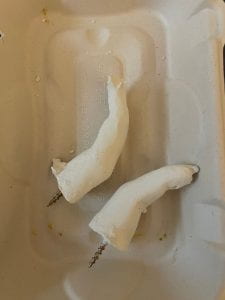For this project, I recalled an elephant-head bag hook that I’d seen on the door of a trendy restaurant’s bathroom, and wanted to pay homage.
In class, we mixed alginate, which I read more about at an NIH article online: “Alginate is a naturally occurring anionic polymer typically obtained from brown seaweed, and has been extensively investigated and used for many biomedical applications, due to its biocompatibility, low toxicity, relatively low cost, and mild gelation by addition of divalent cations such as Ca2+ [4]…” Anyway, once the goo was the right kind of gooey, I inserted a gloved finger (to exaggerate the elephanty wrinkles) and waited. Finger removed, I filled the void with mixed plaster, dangled in a metal screw (secured with tape and a popsicle stick), and left it to cure overnight. Grant de-molded our fingers and brought them home.

At home, I painted the trunk in greyish brown tones with acrylic paints. I traced the profile of the base of my cast finger, then digitally manipulated an elephant image I wantonly screen-shotted, unattributed, from a Google Image search. I printed out the image, cut away what I thought would be an exact, kerfless void for my trunk*, and used Loctite Glass Glue to laminate this image between some scrap plastic I had. The result is ridiculous, but my hook looks better upside down, and therefore has little utility anyway. (*Oops.)


Afterword: If this assignment had been a bigger, longer-term project, I think I would have carved and cast the rest of the elephant’s head (Maybe in plastilina clay?), stuck my finger through, then covered everything in alginate, and finally recast the part (with new, longer screw) all as one 3-D piece.
